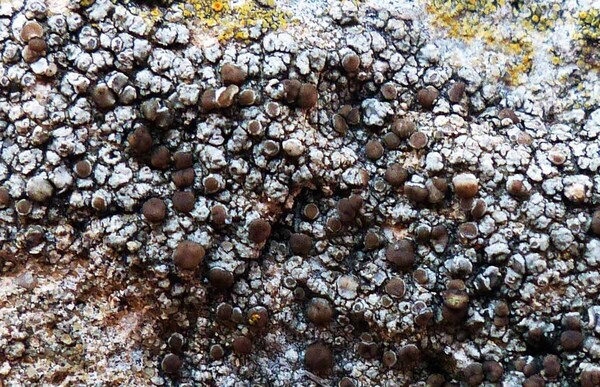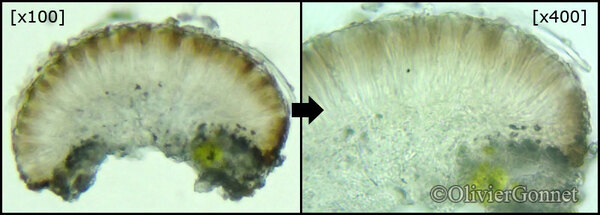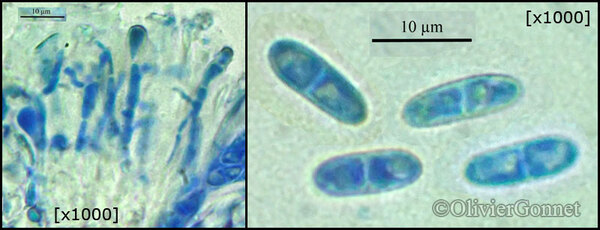Lecania turicensis (Hepp) Müll. Arg.
Flora, 55: 386, 1862. Basionym: Biatora turicensis Hepp - Fl. Eur.: 8, 1853.
Synonyms: Biatorina albariella (Nyl.) Arnold; Biatorina proteiformis A. Massal.; Biatorina proteiformis var. dispersa A. Massal.; Biatorina rabenhorstii var. turicensis (Hepp) Anzi; Biatorina turicensis var. farinosa A. Massal.; Lecania albariella (Nyl.) Müll. Arg.; Lecania erysibe f. dispersa (A. Massal.) Zahlbr.; Lecania erysibe var. proteiformis (A. Massal.) Boistel; Lecania farinosa (A. Massal.) B. de Lesd.; Lecania phaeoleucodes (Nyl.) Zahlbr.; Lecania proteiformis (A. Massal.) Arnold; Lecania subcaesia (Nyl.) B. de Lesd.; Lecaniella rabenhorstii var. turicensis (Hepp) Jatta; Thalloidima barbeyanum Müll. Arg.?; Toninia barbeyana (Müll. Arg.) Zahlbr.?
Distribution: N - VG, Frl (Nimis & Salvadori 1998, Nascimbene & Salvadori 2008, Nascimbene & al. 2009b), Ven (Lazzarin 2000b), TAA (Nascimbene & al. 2022), Lomb (De Vita & Valcuvia 2004, Gheza 2018, Gheza & al. 2015), Piem (Matteucci & al. 2013), Emil (Nimis & al. 1996, Fariselli & al. 2020), Lig. C - Tosc, Marc (Nimis & Tretiach 1999), Umb (Nimis & Tretiach 1999, Ravera & al. 2006, Genovesi 2011), Laz (Bartoli 1997b, Bartoli & al. 1998, Genovesi & al. 2011), Abr, Mol (Nimis & Tretiach 1999, Caporale & al. 2008), Sar. S - Camp (Garofalo & al. 1999, 2010, Aprile & al. 2003b, Nimis & Tretiach 2004), Pugl (Nimis & Tretiach 1999), Bas (Nimis & Tretiach 1999), Cal (Puntillo 1996), Si (Nimis & al. 1994, Poli & al. 1997, Grillo 1998, Caniglia & Grillo 2001, 2005, 2006, Grillo & al. 2001, 2002, Grillo & Caniglia 2004).
Description: Thallus crustose, up to 0.6 mm thick, granular to irregularly areolate, white to pale grey, usually pruinose, the areoles, when developed, 0.3-1.5 mm wide, flat, smooth, corticate, the cortex c. 15–20 μm thick. Apothecia lecanorine, scattered and rounded to crowded and slightly deformed, broadly sessile, up to 0.8(-1) mm across, with a flat to slightly convex, reddish brown to black, often white-pruinose disc (slightly paler and dark-spotted, with a dark pigmented edge when wet), and a thin, pale grey-white pruinose thalline margin which is often excluded in old apothecia (with a few algal cells restricted to the lower edges of the apothecium). Thalline exciple 70–100 μm thick, cupular, densely packed with photobiont cells, with a 15–20 μm thick, colourless or reddish brown outer layer; epithecium brown- to brown-black-spotted, the pigment sometimes partly extending deeper into hymenium; hymenium colourless below, (50-)55-75(-80) µm high, not inspersed with oil droplets; paraphyses strongly coherent, mostly simple, (1.5-)2-2.5 µm thick, the apical cells strongly clavate, up to 6(-7) µm wide; hypothecium colourless, inspersed with scattered oil droplets, 50-100 µm high. Asci 8-spored, clavate, with a K/I+ blue tholus and a central non-amyloid area, Bacidia-type. Ascospores 1-septate, hyaline, ellipsoid or oblong-fusiform, straight, not constricted at septum, thin-walled, (8-)10-15(-18) x (4-)4.5-5.5(-6) µm, without a gelatinous perispore. Pycnidia rare, immersed, dark-brown or black around the ostiole. Conidia thread-like, mostly strongly curved, 12-20 x c. 0.8 µm. Photobiont chlorococcoid. Spot tests: thallus K-, C-, KC-, P-, UV-. Chemistry: without lichen substances. Note: on calcareous rocks, mortar, basic siliceous rocks, brick and roofing tiles, often on man-made substrata, usually below the subalpine belt; probably the most common saxicolous species of the genus in Italy.
Growth form: Crustose
Substrata: rocks
Photobiont: green algae other than Trentepohlia
Reproductive strategy: mainly sexual
Commonnes-rarity: (info)
Alpine belt: absent
Subalpine belt: absent
Oromediterranean belt: absent
Montane belt: rather rare
Submediterranean belt: very common
Padanian area: rather rare
Humid submediterranean belt: very common
Humid mediterranean belt: common
Dry mediterranean belt: rather common
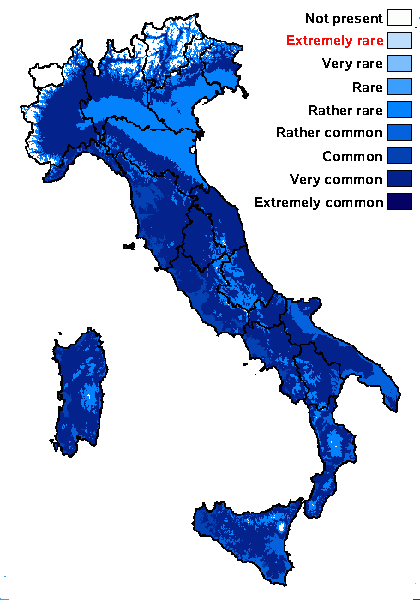
Predictive model
Herbarium samples


P.L. Nimis; Owner: Department of Life Sciences, University of Trieste
Herbarium: TSB (14170)
2002/01/02
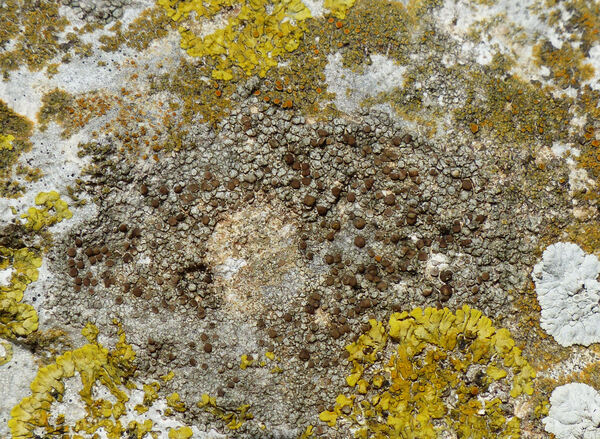

Andrea Moro; Owner: Department of Life Sciences, University of Triedte
Italy, Friuli Venezia Giulia, Trieste, Trieste Karst, Rocca di Monrupino
20/02/2017


Andrea Moro; Owner: Department of Life Sciences, University of Triedte
Italy, Friuli Venezia Giulia, Trieste, Trieste Karst, Rocca di Monrupino
20/02/2017
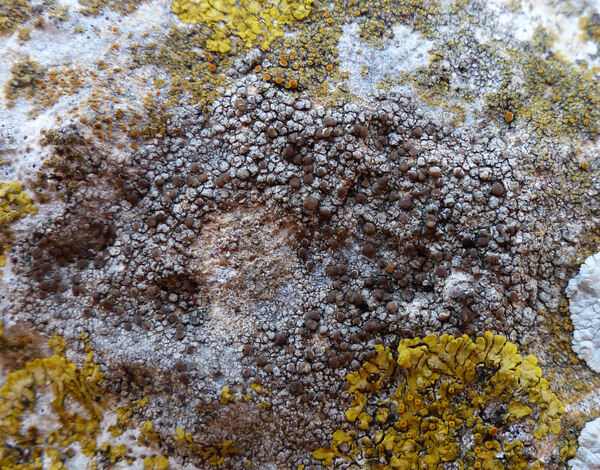

Andrea Moro; Owner: Department of Life Sciences, University of Triedte
Italy, Friuli Venezia Giulia, Trieste, Trieste Karst, Rocca di Monrupino
20/02/2017
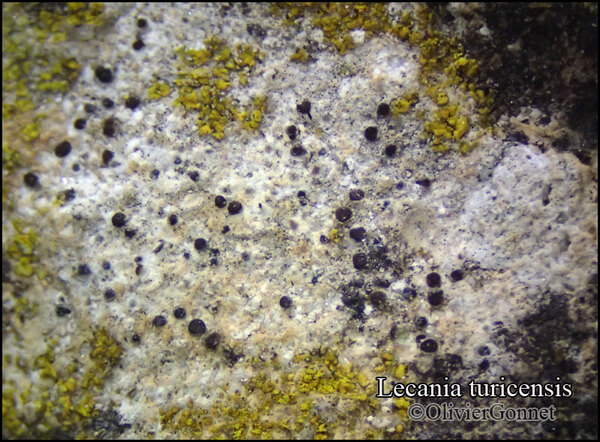
Courtesy Danièle et Olivier Gonnet - Source: https://www.afl-lichenologie.fr/Photos_AFL/Photos_AFL_L/Texte_L_3/Lecania_turicensis.htm
France, session AFL 2015 - Saint-Sozy - Lot
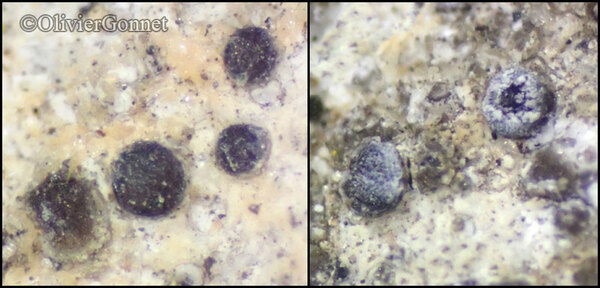
Courtesy Danièle et Olivier Gonnet - Source: https://www.afl-lichenologie.fr/Photos_AFL/Photos_AFL_L/Texte_L_3/Lecania_turicensis.htm
France, session AFL 2015 - Saint-Sozy - Lot
Growth form: Crustose
Substrata: rocks
Photobiont: green algae other than Trentepohlia
Reproductive strategy: mainly sexual
Commonnes-rarity: (info)
Alpine belt: absent
Subalpine belt: absent
Oromediterranean belt: absent
Montane belt: rather rare
Submediterranean belt: very common
Padanian area: rather rare
Humid submediterranean belt: very common
Humid mediterranean belt: common
Dry mediterranean belt: rather common

Predictive model
| Herbarium samples |


P.L. Nimis; Owner: Department of Life Sciences, University of Trieste
Herbarium: TSB (14170)
2002/01/02


Andrea Moro; Owner: Department of Life Sciences, University of Triedte
Italy, Friuli Venezia Giulia, Trieste, Trieste Karst, Rocca di Monrupino
20/02/2017


Andrea Moro; Owner: Department of Life Sciences, University of Triedte
Italy, Friuli Venezia Giulia, Trieste, Trieste Karst, Rocca di Monrupino
20/02/2017


Andrea Moro; Owner: Department of Life Sciences, University of Triedte
Italy, Friuli Venezia Giulia, Trieste, Trieste Karst, Rocca di Monrupino
20/02/2017

Courtesy Danièle et Olivier Gonnet - Source: https://www.afl-lichenologie.fr/Photos_AFL/Photos_AFL_L/Texte_L_3/Lecania_turicensis.htm
France, session AFL 2015 - Saint-Sozy - Lot

 Index Fungorum
Index Fungorum
 GBIF
GBIF
